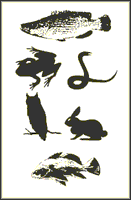Nebraska Cooperative Fish and Wildlife Research Unit

Nebraska Cooperative Fish and Wildlife Research Unit: Staff Publications
Date of this Version
10-2005
Citation
Published in Fisheries Research 76 (October 2005), pp. 117-122; doi: 10.1016/j.fishres.2005.05.013
Abstract
We correlated maximum lengths of freshwater fishes captured during 10 years with standard gears (i.e., gill nets, boat electrofishers and trap nets) and angling from Nebraska water bodies to determine which methodology provided better estimates of maximum size of fishes produced within a given water body. In general, maximum length of fishes captured with standard gears was smaller than maximum length of fishes captured with angling. Although significant (based on sequential Bonferroni adjustment) correlation was found in only one of nine sport fishes assessed, all correlations were positive indicating a general trend between maximum size of fishes captured with these two methodologies. At present, one cannot reliably predict the maximum size of fishes that is likely to be caught with angling given the maximum size of fishes captured with standard gears during routine monitoring of a fishes population.
Included in
Aquaculture and Fisheries Commons, Environmental Indicators and Impact Assessment Commons, Environmental Monitoring Commons, Marine Biology Commons, Natural Resources Management and Policy Commons, Water Resource Management Commons


Comments
Copyright © 2005 Elsevier B.V. Used by permission.